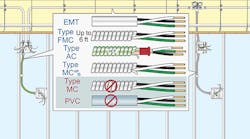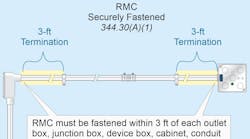All questions and answers are based on the 2011 NEC.
Q. What are the rules regarding grounding receptacles, lights, and equipment in wiring methods for patient care areas?
A. Wiring in patient care areas must comply with the requirements of 517.13(A) and (B).
Note: Patient care areas include patient rooms as well as examining rooms, therapy areas, treatment rooms, and some patient corridors. They don’t include business offices, corridors, lounges, day rooms, dining rooms, or similar areas not classified as patient care areas [517.2].
All branch circuits serving patient care areas must be provided with an effective ground fault current path by installing circuits that serve patient care areas in a metal raceway or cable having a metallic armor or sheath that qualifies as an equipment grounding conductor in accordance with 250.118 [517.13(A)] (Figure).
The metal outer sheath of AC cable is listed as an equipment grounding conductor because it contains an internal bonding strip in direct contact with the metal sheath of the cable [250.118(8)]. The metal outer sheath of interlocked Type MC cable isn’t listed as an equipment grounding conductor unless it contains an uninsulated equipment grounding/bonding conductor and it’s listed and identified as an equipment grounding conductor.
Once the bare aluminum grounding/bonding conductor exits the cable, it can be cut off because it no longer serves any purpose. Furthermore, the effective ground fault current path must be maintained by the use of fittings specifically listed for the cable [330.40]. See 300.12, 300.15, and 330.100.
Additionally, the following must be directly connected to an insulated copper equipment grounding conductor that’s
installed with the branch circuit conductors in wiring methods required in 517.13(A) [517.13(B)(1)]:
(1) The grounding terminals of all receptacles.
(2) Metal enclosures containing receptacles.
(3) Fixed electrical equipment operating at more than 100V.
Exception: An insulated equipment bonding jumper from a receptacle that directly connects to the equipment grounding conductor is permitted.
Exception No. 1 to (3): Metal faceplates for switches and receptacles can be connected to the equipment grounding conductor by the metal mounting screws that secure the faceplate to a metal outlet box or metal mounting yoke of switches [404.9(B)] and receptacles [406.4(C)].
Exception No. 2 to (3): Luminaires located more than 7½ ft above the floor can be connected to the equipment grounding return path complying with 517.13(A), without being connected to an insulated equipment grounding conductor.
Equipment grounding conductors and equipment bonding jumpers must be sized in accordance with 250.122.
Q. What is the rule regarding receptacles with insulated grounding terminals (isolated ground) in patient care areas?
A. Receptacles having insulated grounding terminals (isolated ground receptacles) [250.146(D)] aren’t permitted to be installed in patient care areas [517.16].




